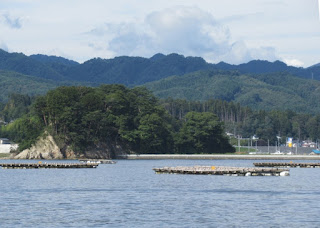I
made my regular visit to Iwate Prefecture. This time, I stayed in Miyako City
and Yamada Town to see their autumn festivals as well as current situations.
I joined Miyako's festival in the evening of Sept. 16.
A group of Minamikawame district (local community) performed Sansa-Odori dance. The members included many young people.
A carrier with a sail canvas moved around.
A dram performance was played by a group of Yamaguchi-daiko (dram). Strong sounds spread around the streets. (See the 4th photo from the top)
another team performed a dance with big flags.
Local
people as well as visitors enjoyed the festival.
The
portable shrines or mikoshi are carried from a shrine to another shrine in the festival. Boats are used to move them. Fish boats join the ceremony and compose a sea parade in the port.
The mikoshi was just landed when I arrived at the port. (See also the top photo)
The mikoshi was just landed when I arrived at the port. (See also the top photo)
In addition to their regular plays, they
hold special performances for specific people who make donations for them.
We asked a team of Daikagura to play a lion dance for us. (See also the 3rd photo)
It was impressive that many young
people joined the festivals, both as players and visitors, in Miyako and Yamada. I also felt strong ties of the people in the local communities.
It
is often said that the festivals and traditional performing arts played
important roles in the process of recovery from the Great East Japan Earthquake and tsunami disasters in March 2011. I reaffirmed the idea.
In
addition to the festivals, I visited Taro district in Miyako City. It was my
first visit in four years. Taro is famous for its huge
seawalls, which were destroyed by the tsunami disasters in 2011.
New roads,
shops, a baseball stadium and other facilities have been developed in the central parts of the district.
Still there remains a question on the future developments of the district. It is similar in most quake-hit areas in Tohoku.
I experienced a cruising in the Yamada Bay. There are many cultivation rafts of oysters and scallops in the bay
A
raft is about 12x4 meter large. It takes two to three years to grow
oysters. (See also the 5th photo)
The
rafts were all washed away in 2011, when they had tsunami disasters. Now, they have about 2,000 rafts.



























